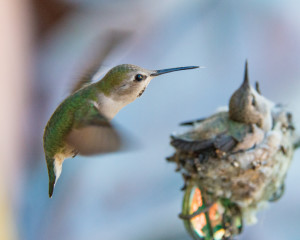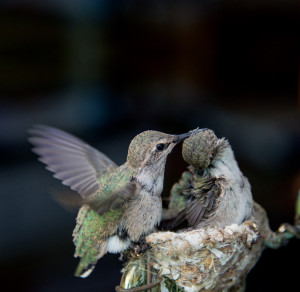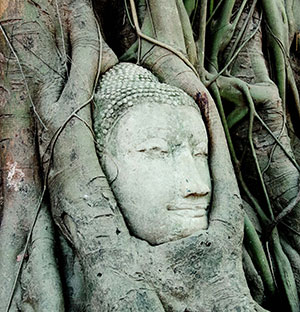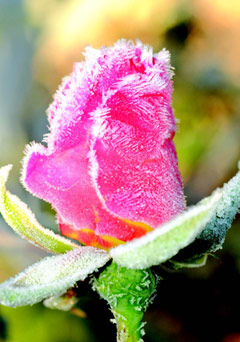A Photo Essay by Susan Wood
Hummingbird nests are so small and well camouflaged that you can look right at one and never see it. So it was just by luck that my neighbor discovered the hummingbird nest built on a wind chime in her back yard. When I first saw the nest, the two baby hummingbirds had just hatched from eggs the size of a Tic Tac. They were no bigger than a penny, had short, stubby beaks, no feathers, dark skin, and closed eyes.
Not wanting to miss a moment, I grabbed my camera and became a fixture in my neighbor’s backyard. I spent the next three weeks up close (on a ladder) and personal with the chicks and their mother—watching, waiting, and learning everything I possibly could about them.
Momma returned every 20 to 25 minutes to feed her babies. Each time she came back, she would buzz around me, coming in closer and closer, sometimes so close she would tickle my cheek with the wind from her wings.
Within a couple of days, the baby hummingbirds almost doubled in size and began to grow little fuzzy pinfeathers. After one week, they were covered in these fuzzy feathers making them look like miniature prickly balls.
By two weeks, the babies were completely covered in pin feathers and starting to grow real feathers, and their beaks had become much longer. At almost three weeks old, the little babies looked more like real hummingbirds. They tested out their wings more and more, preparing for their first flight.
By three weeks, the chicks had become full grown adults and flew away. As for me, I am still recovering from “empty nest syndrome!”
………………………
Fun Facts
• Hummingbirds are the tiniest birds in the world.
• They get their name from the humming sound produced by their wings when in flight.
• Early Spanish explorers called hummingbirds flying jewels.
• Hummingbirds are extremely smart and can remember every flower they have been to, and how long it will take a flower to refill. They will visit an average of 1,000 flowers per day. They remember year to year, where each and every hummingbird feeder is, both at home and along their migration path.
• Hummingbirds have the highest metabolism of any animal on earth (roughly 100 times that of an elephant).
• They need to eat on average seven times per hour and will consume anywhere from half to eight times their body weight in one day.
• Hummingbirds do not “drink” nectar from flowers and feeders. They lap it with their tongues, which are grooved (like the shape of a “W”) and have tiny hairs on the tip to help gather the nectar.
• Hummingbirds are great little hunters and need to eat bugs for protein. Being very resourceful, they have even been known to steal little bugs out of a spider’s web, then eat the spider and steal the web to build their own nest.
• Toilet training of baby hummingbirds comes built in (a definite benefit of being a hummingbird mom). The baby hummingbirds will do everything they can to dispose of waste over the side of the nest. But, a word of caution: If you are lucky enough to be that close to a nest, DO NOT stand next to a baby hummingbird after it’s fed!
• When they sleep (daily), hummingbirds go into a hibernation-like state called Torpor (TOR-per). Their metabolism lowers to one-fifteenth (1/15) of normal. Their body temperature drops to the point of becoming hypothermic. Their heart rate drops to about 50 beats per minute. Their breathing slows to the point that it looks like they have stopped breathing. By sleeping like this, hummingbirds can save up to 60% of their available energy. When in the Torpor state, they can appear to be dead and occasionally have been found hanging upside-down.
• Hummingbirds are the original helicopters. They are the only birds that can fly both forward and backwards and can also hover in mid-air, fly sideways and even upside-down.
• They can fly an average of 25-30 miles per hour and reach 60 mph when diving.
• They have the fastest wing beats of any bird, around 70 beats per second and up to 200 beats per second during a high speed dive.
• A hummingbird’s heart can beat up to 1,260 beats per minute, 250 times per minute at rest.
• An average sized hummingbird will have about 940 feathers. This is more feathers per square inch of their body than any other bird in the animal kingdom.
• Hummingbirds have very large eyes in proportion to their body weight. The eyes are set on the side of the head allowing the hummingbird to see both ahead (binocular vision) and on the side peripherally (monocular vision). Hummingbirds have many more rods and cones than humans in their eyes to help them see well. This makes them better able to see colors and ultraviolet light.
• Hummingbirds have regular eyelids to block light from each eye but also have a third eyelid call a Nictitating Membrane that is clear and will protect the hummingbird’s eyes while flying.
• A hummingbird has two ears located on each side of its head to improve hearing, and can easily decipher small fluctuations of tones better than most humans.
• Hummingbirds have very weak feet and can barely walk (they like to perch and spend most of their life perching).
• 30% of a hummingbird’s weight consists of flight muscles. Human pectoral muscles are about 5% of body weight.
• A hummingbird can weigh anywhere between 2 and 20 grams. A penny weighs 2.5 grams.
• Depending on the type or species of hummingbird, the little babies weigh approximately 0.62 grams. That’s one-third the weight of a United States dime.
• If a hummingbird survives its first year, it will live for an average of five years. Unfortunately, only about 20% of hummingbirds survive their first winter.
• Hummingbirds are found as far north as Alaska and as far south as Chile.
• There are more than 300 species of hummingbirds.
……………………….
Hummingbird nests are made of plant down and other soft materials, glued together with spider webs. The spider webs allow the nest to stretch and be flexible as the baby hummingbirds grow. The bottom and wind side of the nest are usually thicker than the top and leeward side. This helps regulate the temperature inside the nest.
Most hummingbird nests look like a small cup about the size of a walnut shell, and range from having the diameter of a penny to about an inch and a half when completed.
When a mother hummingbird comes to feed her chicks, the babies feel the wind from her wings and lift their heads up and open their mouths. The mother inserts her beak all the way down into the mouths of the babies while dropping a mixture of regurgitated insects and nectar inside. When the mother hummingbird does this, you can see her throat swell as she pumps the baby food out of her beak in an up and down motion, kind of like a sewing needle on a sewing machine.
Baby hummingbirds will usually have enough feathers to regulate their own body heat by about nine days after hatching. The mother hummingbird will no longer need to sit on the nest all the time. This works well because the baby hummingbirds are now too big for the mother hummingbird to fit inside the nest anyway.
The baby hummingbirds will start stretching their wings by gripping the floor of the nest with their feet and flapping away. By hanging on to the nest, the baby hummingbirds will not have to worry about accidentally flying away too soon.
Hummingbirds are very clean and groom themselves quite often.
Some feathers on a hummingbird hold bright radiant color. This coloring comes from iridescent coloring like on a soap bubble or prism and requires sunlight to show these colors off.
…………………
Special thanks to my neighbor Marilyn for letting me “camp out” in her backyard for three weeks and to her granddaughter Hailey for helping me with the research for this project.
Resources: World of Hummingbirds – www.Worldofhummingbirds.com
Wild Birds Unlimited – www.wbu.com
For additional photographs, go to susanwoodphotography.com
























